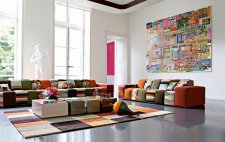Seating area design

Once you’ve decided on a size and the general boundaries for your seating area, you’re ready to install hardscaping, including one of the most important elements: flooring.
When selecting materials for the floor of a seating area, there are many options to choose from, including stone, brick, pavers, concrete, and gravel. In terms of making your selections, let the intended use and your budget be your guides.
When setting a budget for materials, I encourage clients to put their hardscaping dollars into their most lived-in areas. I’m a fan of using stone whenever possible because it feels natural and, if properly installed, provides a wobbleproof surface for furnishings. It’s often, however, on the higher end of the price continuum. Concrete is a great alternative to stone. It is typically less expensive per square foot (sometimes costing even less than pavers), easily adapts to irregular shapes, and lends itself to creative designs and finishes.
Gravel is probably the cheapest flooring option. It may not seem appealing, but you can easily dress up your gravel patio by including crisp edges to define the area. Steel edging, pavers, or brick set on edge are a couple of ways to establish clean lines while adding visual interest. Avoid using gravel directly outside of entry points to the home, however, because it can easily get tracked inside. With gravel, as with stone, you’ll likely have to weed out seedlings that blow in and germinate in the cracks, but this is typically an easy chore.
Though one flooring material can do the job, you don’t have to limit yourself. A mix of materials can be effective in reinforcing your underlying design concept. Use materials wisely, however, so as not to create a chaotic feel. Small gardens, especially, need a streamlined palette of textures and materials. Using brick to edge a flagstone or concrete patio, for instance, can be an effective combination of materials that lends unity to your design (photo, facing page).
Before making your final flooring selections, consider the area’s eventual use and likely furnishings. Furniture with slender feet, like those of metal chairs, require paving with more tightly spaced joints for stability. Traction is also important. Brick, as well as concrete and stone, can be slippery when wet or mossy. Make your final decision based not only on your style and budget but also on the practicality of the materials in your living space. Then, get busy installing it.
Related posts:

 Layout for Small Rooms Strip/Basic Home Office Layout. C. Roseberry Create a Functional and Organized Workspace Tired of working in your home office because it s…
Layout for Small Rooms Strip/Basic Home Office Layout. C. Roseberry Create a Functional and Organized Workspace Tired of working in your home office because it s… This cozied-up formal dining room is wonderful for those who have a large family or group of friends and often find themselves throwing dinner parties or hosting…
This cozied-up formal dining room is wonderful for those who have a large family or group of friends and often find themselves throwing dinner parties or hosting… Will it work in the space I have planned? Our published dimensions (e.g. 93 Wx46 Dx32 H) width x depth x height in inches, will help you decide if your furniture…
Will it work in the space I have planned? Our published dimensions (e.g. 93 Wx46 Dx32 H) width x depth x height in inches, will help you decide if your furniture… Schlafzimmer: Ideen, von der Einrichtung bis zur Deko Überlegen Sie sich vor dem Einrichten die Anordnung Ihrer Schlafzimmermöbel. Ist der perfekte Standort für…
Schlafzimmer: Ideen, von der Einrichtung bis zur Deko Überlegen Sie sich vor dem Einrichten die Anordnung Ihrer Schlafzimmermöbel. Ist der perfekte Standort für… Like Architecture & Interior Design? Follow Us A three-bedroom home can be the perfect size for a wide variety of arrangements. Three bedrooms can offer…
Like Architecture & Interior Design? Follow Us A three-bedroom home can be the perfect size for a wide variety of arrangements. Three bedrooms can offer…